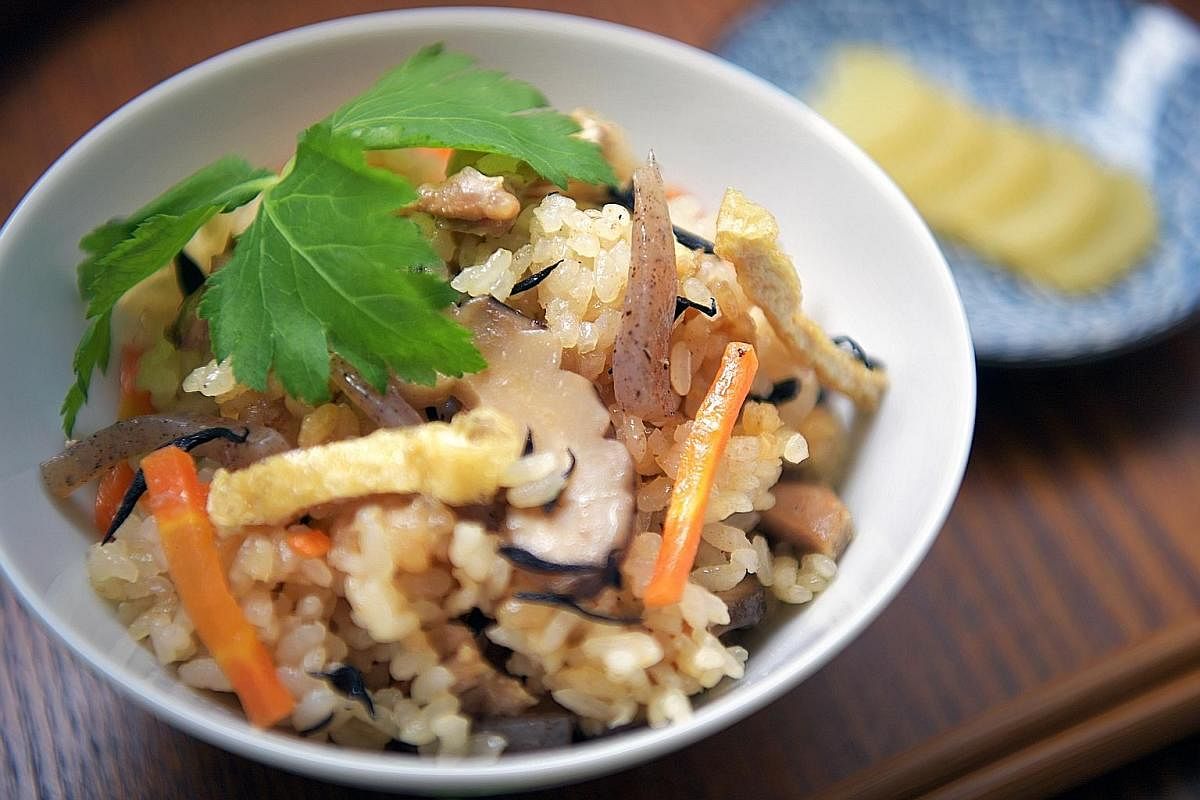-
TAKIKOMI GOHAN
-
INGREDIENTS
3 dried shiitake mushrooms
2 cups rice, measured using the cup that comes with the rice cooker, about 300g
20cm by 10cm piece of konbu
500ml water
20g bonito flakes
1 skinless, boneless chicken thigh
1 Tbs shoyu
1 Tbs mirin
1 Tbs sake
1 aburaage (photo 1)
50g konnyaku (photo 2)
50g carrot
1 tsp salt
1 tsp dried hijiki seaweed (photo 3)
Mitsuba (photo 4) or chopped scallions for garnish
-
METHOD
1. The night before cooking, rinse the mushrooms under running water and soak in tap water overnight at room temperature.
2. On the day of cooking, rinse the rice four to five times under running water, until the water becomes clear. Soak in fresh tap water for 45 minutes. After that, pour the rice into a fine mesh strainer, set it over a bowl and let drain for 15 to 20 minutes.
3. While the rice is soaking, make the dashi. Wipe the konbu with a damp paper towel. Place in a medium pot and pour the water over it. Soak for 30 minutes. Place the pot over medium low heat until small bubbles appear on the circumference of the pot. Remove the konbu or the dashi will be bitter. Bring the water to a rolling boil. Turn off the heat and add the bonito flakes. Let the flakes sink to the bottom. Drain the dashi into a pouring jug and set aside.
4. Rinse the chicken under running water and pat very dry with paper towels. Cut into bite-sized pieces and place in a small bowl. Add the shoyu, mirin and sake, stir and let marinate.
5. Bring a medium pot of water to boil and add the aburaage. Let it sit in the boiling water for two minutes, turning it over with a pair of chopsticks after one minute. Remove from the pot. Add in the konnyaku and let it boil in the water for two to three minutes. Remove from the pot.
6. Dry the aburaage with paper towels, squeezing out the water. Slice in half lengthwise, and then into thin strips crosswise. Cut the konnyaku into matchstick-size pieces. Peel the carrot and cut into matchstick-size pieces. Slice off the stems of the shiitake mushrooms and slice the caps thinly.
7. When the rice has had its soaking and draining time, scrape it into the rice cooker pot. Add the salt. Drain the marinade from the chicken and add the marinade to the rice. Add the dashi to the two-cup mark in the pot. You will need about 400ml. Give the rice a good stir.
8. Spoon the chicken evenly over the rice. Add the carrot, then mushroom, konnyaku, aburaage and hijiki in layers. Do not stir. Cook the rice using the White or Mixed function on the cooker. When the rice is done cooking, let it rest 10 minutes before opening the pot.
9. Use a rice paddle to mix the ingredients up in the pot, using a cutting motion.
10. Spoon the rice into bowls, top with mitsuba or scallions, and serve with pickles, miso soup and a salad.
Serves four as a main dish
Hunger Management
Inspired by manga to cook a pot of mixed rice
Uncovering a whole world of food manga, including one on The Joy Of Rice, gets me thinking about my adventures in cooking Japanese rice





For someone a little obsessed with Japanese culture, it has taken me too long to discover manga.
Until this year, I had never read a Japanese comic and now, it seems, I cannot stop. How do I nip the addiction in the bud when I have discovered a whole world of food manga, translated into English? How do I stop trawling the Internet for videos made by manga fans who cook the dishes they read about in the books?
It started when I decided to unplug for a short spell earlier this year. I switched off my mobile phone. I read books. I wrote. On paper. With a pen.
That was one of the best weeks of my life and it was made better by Oishinbo.
I stumbled on the series before unplugging, while ordering shoyu online. The manga series, which made its debut in 1983, is written by Tetsu Kariya, with art by Akira Hanasaki. Its title is a mash-up of the words oishi (Japanese for delicious) and kuishinbo (someone who loves to eat). There have been more than 100 volumes of the comic, which has also been made into an anime series and movie.
Oishinbo is about the eating adventures of Shiro Yamaoka, an angsty journalist for Tozai News who does not seem to have to work with deadlines the way people like me do. He does, however, have a very finely honed palate and the way he geeks out on food thrills me.
He and Yuko Kurita, his girlfriend and later, wife, are joined on their food adventures by colleagues in the newspaper.
Underlying the series is Yamaoka's very testy relationship with his father Yuzan Kaibara, a celebrated artist and founder of The Gourmet Club. He has, arguably, an even more refined palate than his son.
Both are competing against each other by trying to create a menu to beat all menus, for rival newspaper companies.
The English translations are grouped into seven books: Japanese cuisine; Sake; Ramen & Gyoza; Fish, Sushi & Sashimi; Vegetables; The Joy Of Rice and Izakaya. They are available from Amazon.com for between US$10 (S$13.60) and US$13.
Unlike the Japanese volumes, the books are disjointed because they are grouped according to themes, so the timelines jump from chapter to chapter.
It can be disconcerting, but not to me. I lapped up the books in doublequick time, marvelling at all I was learning about Japanese food through comics.
Although the series started in the 1980s, the issues it brings up are relevant today. Pollution, changing lifestyles, the quest for cheaper food, international trade and their effects on how people eat apply all over the world.
One of the chapters in The Joy Of Rice is about foreign rice imports to Japan, a sensitive subject even today. Another hilarious chapter debunks the myth that organically grown brown rice is better than white, when starving members of a women's judo team, tired of the tasteless brown rice they are forced to eat, ask the intrepid newspaper gang for properly cooked white rice.
All of this gets me hungry and I get to thinking about my own adventures cooking Japanese rice. Before I bought myself a Japanese rice cooker, I swore by the proportions of rice to water set out in Elizabeth Andoh's Washoku. Things have become a lot easier.
S, a good friend, told me how soaking Japanese rice before cooking makes all the difference, and indeed it does. It tastes better. Draining the rice after soaking is just as important.
Another friend, K, waxed lyrical about a homestyle rice dish she had while on holiday in Japan.
Turns out it was takikomi gohan or mixed rice, which I love.
If there is one thing I have learnt reading Oishinbo, it is to respect ingredients. Yes, it is possible to cook rice without soaking and draining, but why not take the trouble for better tasting rice? After all, the koshihikari rice from Niigata prefecture I use is not cheap.
I suppose I could have cooked it with dashi from a packet, but again, why? It takes no time at all to make it from scratch, and if the Japanese supermarket runs out of konbu (sounds crazy but it happens), well, I just go to another one, gnashing my teeth the whole way.
The recipe calls for pretty classic ingredients: chicken, carrot, konnyaku, hijiki and dried mushrooms. However, there are many other possibilities: ginkgo nuts, lotus root, fresh mushrooms, chestnuts, sweet potato, bamboo shoots, salmon, octopus or pork.
Remember, however, that this is a rice dish and the grain should shine. The temptation is to load the rice with ingredients, but there are plenty in the recipe.
People sometimes think of rice as an accompaniment to other "more important" offerings on the dinner table. Others even shun it and focus on the protein.
That is unfortunate. A properly cooked pot of rice is something to savour.
Oishinbo reminded me of that and I raise a glass of sake to Kariya-san.
Join ST's Telegram channel and get the latest breaking news delivered to you.
A version of this article appeared in the print edition of The Sunday Times on October 22, 2017, with the headline Inspired by manga to cook a pot of mixed rice. Subscribe

